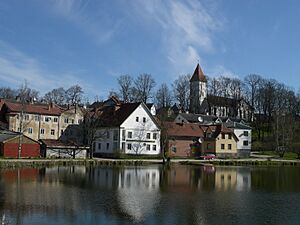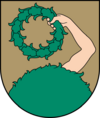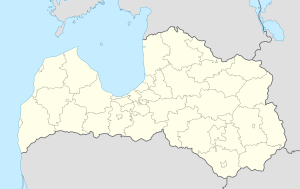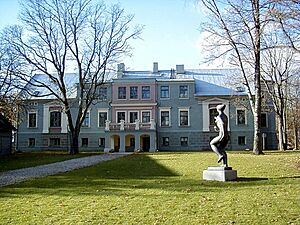Talsi facts for kids
Quick facts for kids
Talsi
Livonian: Tālsa
|
|||
|---|---|---|---|
|
Town
|
|||

Talsi
|
|||
|
|||
| Country | |||
| District | Talsi Municipality | ||
| Town rights | 1917 | ||
| Area | |||
| • Total | Lua error in Module:Wd at line 1,575: attempt to index field 'wikibase' (a nil value). km2 (Formatting error: invalid input when rounding sq mi) | ||
| • Land | Lua error in Module:Wd at line 1,575: attempt to index field 'wikibase' (a nil value). km2 (Formatting error: invalid input when rounding sq mi) | ||
| • Water | Expression error: Unexpected < operator. km2 (Formatting error: invalid input when rounding sq mi) | ||
| Population
(2024)
|
|||
| • Total | 8,649 | ||
| Time zone | UTC+2 (EET) | ||
| • Summer (DST) | UTC+3 (EEST) | ||
| Postal code |
LV-320(1–3)
|
||
| Calling code | +371 632 | ||
| Number of city council members | 19 | ||
| Website | http://www.talsunovads.lv/ | ||
Talsi is a charming town located in Latvia. It is often called the "green pearl of Courland" because of its beautiful natural setting. Talsi is the main town of the Talsi Municipality, where important local government offices are located.
Contents
Understanding the Name of Talsi
It is thought that the name "Talsi" comes from an old word in the Livonian language. This word, talusse, means "secluded place" or "hidden spot". This name fits well with the town's peaceful and green surroundings.
A Look at Talsi's Past
Early Days and Growth
Talsi has a very long history. A special hill fort was built here by the Curonians as early as the 10th century. This shows that people lived in Talsi a very long time ago. The town was first written about in 1231. This was in an agreement between a Curonian tribe and a special visitor from the Pope.
Later, during a time called the Northern Crusades, German rulers took control of the area. They built a castle in Talsi in the late 1200s. The town grew bigger in the 1400s as traders and craftspeople from German-speaking lands moved in. The main church you see today was opened in 1567. A close friend of the famous composer Ludwig van Beethoven, Carl Amenda, worked there for many years.
During the time of Duke Jacob Kettler, an iron factory was built in Talsi. This was an early step for industry in the town. Sadly, Talsi suffered from a serious illness called the plague two times, in 1657 and 1710. A big fire also damaged the town in 1733. In 1795, Talsi became part of the Russian Empire. At that time, many people living in Talsi were of German background.
New Beginnings and Challenges
Towards the end of the 1700s, Jewish families were allowed to live in Talsi for the first time. Many came from Lithuania. Over time, they became a big part of the town's population. A synagogue (a Jewish place of worship) was built in Talsi.
In 1863, an elementary school opened, and a private school followed in 1873. These schools first taught only in German. Later, in 1887, a Russian-language school also opened. During the Revolution of 1905, there was some trouble in Talsi. Some buildings were burned, and people were hurt.
World War I caused great hardship for Talsi. The town's population dropped from about 5,000 to only 1,100 people. Many Jewish residents had to leave the town during this time. Peace finally returned in 1920, when the Latvian War of Independence ended. Talsi then became part of the new country of Latvia.
Talsi in Modern Times
After Latvia became independent, Talsi quickly grew again. By 1935, it had 4,116 people. Most were Latvians, but there were also Jewish and German residents. The town was under German control from 1941 until the end of World War II in 1945. During this time, the Jewish community in Talsi faced terrible persecution.
In the 1950s and 1960s, Talsi saw a period of growth. A metalworking factory opened in 1965, creating many jobs. After the dissolution of the Soviet Union and Latvia became independent again, a special sculpture was finally put up. This sculpture, called Koklētājs, honors Latvian freedom fighters. It was started in the 1930s but could only be finished after the Soviet Union ended.
Exploring Talsi's Landscape
Talsi is famous for its unique landscape. It is built around nine hills and two beautiful lakes. The hills have interesting names like Pilskalns, Ķēniņkalns, Leču kalns, Tiguļu kalns, Sauleskalns, Baznīckalns, Krievragkalns, Vilkmuižas kalns, and Dzirnavkalns.
Pilskalns means "castle hill." This is where the old hill fort used to be. It is 32 meters (about 105 feet) high and is right in the middle of town. Scientists studied the hill fort here from 1936 to 1938.
The tallest hill in Talsi is Tiguļu kalns. On this hill, you can find an arboretum, which is like a park with many different kinds of trees. The Talsi Regional Museum is also located here. It is in a grand old house that was once owned by a local noble, Baron von Firck.
On Leču kalns, there is a special sculpture. It remembers the Revolution of 1905, when six brave people were killed there. Talsi lake is in the center of the town. You can walk around it on a nice path, and there is even a fountain in the lake.
Culture and Places of Worship
Talsi has a regional museum, as mentioned before, located in the old manor house. There is also a cultural center with a "creative yard" in the town. Talsi has two libraries, including one especially for children.
You can find churches of different Christian faiths in Talsi. There are Lutheran, Catholic, Baptist, and Seventh-Day Adventist churches. The old synagogue is now a private home. The Lutheran church, built in 1567, is the oldest stone building in Talsi. It has been rebuilt several times over the years.
Sports and Activities
Talsi has its own municipal sports school, where young people can learn and train. The town also hosts an annual rally competition, which is a type of car race. There are many sports facilities for activities like skating, ice hockey, and association football (soccer).
Getting Around Talsi
You can travel to Talsi from Riga by bus. The journey takes about two hours. There is also a small airfield about 1 kilometer (0.6 miles) outside Talsi. It is used for small planes and sometimes for special events.
Famous People from Talsi
Many interesting people have come from Talsi:
- Karl Friedrich Amenda (1777-1836), a composer and friend of Ludwig van Beethoven.
- Vera Zozulya (born 1956), a luger (someone who rides a small sled down an icy track).
- Uvis Helmanis (born 1972), a basketball player.
- Raimonds Tiguls (born 1972), a musician and composer.
- Romāns Vainšteins (born 1973), a cyclist.
- Intars Busulis (born 1978), a popular singer.
- Jānis Strēlnieks (born 1989), a basketball player.
- Dzintars Čīča (born 1993), a singer.
Annual Events in Talsi
Talsi hosts many fun events each year:
- The International Carl Ferdinand Amenda Music School Competition is for young musicians aged 7–17.
- The "Talsi Celebration" happens every July.
- A market fair takes place at the end of August.
- There are special days dedicated to poetry and art.
- National holidays like Independence Day (November 18) and Lāčplēsis Day are also celebrated.
Talsi's Sister Cities
Talsi has special connections with other towns around the world, called sister cities:
 Alanya, Turkey
Alanya, Turkey Lejre, Denmark
Lejre, Denmark Orhei, Moldova
Orhei, Moldova Prienai, Lithuania
Prienai, Lithuania Saaremaa, Estonia
Saaremaa, Estonia Shchyolkovo, Russia
Shchyolkovo, Russia Söderköping, Sweden
Söderköping, Sweden Telavi, Georgia
Telavi, Georgia
Images for kids
See also
 In Spanish: Talsi para niños
In Spanish: Talsi para niños








